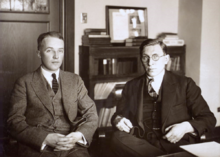Frederick Grant Banting
Frederick Grant Banting (November 14, 1891, Alliston, Ontario - February 21, 1941, Musgrave Harbor, Newfoundland) was a Canadian physician and researcher.
He studied at the University of Toronto and was a military medic during World War I. He later became an assistant physiologist at the University of Western Ontario and from 1921 a professor at the University of Toronto.
In 1921, he discovered the hormone insulin with Charles Best. For this discovery he was awarded the 1923 Nobel Prize in Physiology and Medicine, shared with John James Richard Macleod. He received the award at just 32 years old, making him the youngest scientist ever to be awarded the Nobel Prize in Physiology and Medicine.
His latest research at the Institute concerned cancer, the adrenal cortex, and silicosis.
During World War II he was a major in the Medical Corps and head of the medical section of the National Research Council of Canada. He died in Newfoundland in a plane crash.
Biography
Banting was born in Alliston, Ontario, Canada, on November 14, 1891. He was the youngest of the five children of William Thompson Banting and Margaret Grant. He did his first studies at Alliston. He started theology at the University of Toronto, which he soon changed to medicine. He graduated in 1916. He served in the Canadian Army Medical Corps and participated in World War I in France. In 1918 he was wounded in the Battle of Cambrai. He lived for a short time in London (Ontario). He studied children's orthopedics and practiced as a surgeon at the Hospital for Sick Children, between 1919 and 1920. A year later he was Professor of Orthopedics at the University of Western Ontario. The academic year 1921-1922 he gave lectures on pharmacology at the University of Toronto. He obtained the degree of doctor in 1922.
Medical Research
Discovery of insulin
Very early on, he became interested in diabetes. Since the end of the 19th century, scientists had been aware of the relationship between the pancreas and diabetes. Some studies indicated that the disease was caused by a lack of a hormone secreted by the islets of Langerhans of the pancreas. Oscar Minkowski and others tried to isolate this hormone without success. Schafer called it "insulin" and it was supposed that it exercised control over sugar metabolism, in such a way that its absence caused its increase in blood and urine. An attempt was made to administer extract of the pancreas or the fresh gland to diabetics, a treatment that failed because the hormone had to be destroyed by proteolytic enzymes. On the other hand, blood and urine glucose detection techniques were still unsafe. Reading an article by Moses Baron in which it was said that ligation of the pancreatic duct caused degeneration of the cells that secreted trypsin, but that the islets remained intact caught his attention. He thought that he could resort to this procedure to obtain insulin.
He contacted J.J.R. Macleod, professor of physiology at the University of Toronto, who provided him with what was necessary to be able to investigate in his laboratory. He then worked with Charles Best, a medical student, who was his assistant, and later with the chemist James B. Collip. In August 1921, they administered insulin obtained from the islets of Langerhans to diabetic dogs, verifying that blood and urine sugar levels dropped and the typical symptoms of the disease disappeared. They repeated the experiments several times with different results, depending on the purity of the insulin used. It was Collip who took it upon himself to achieve one that was as pure as possible. They used it for the first time, a few weeks later, on a fourteen-year-old diabetic boy, who made an extraordinary improvement from his disease.
The first description of the results obtained with the use of insulin in diabetes appears in the article "Pancreatic extracts in the treatment of diabetes mellitus" (Pancreatic Extracts in the Treatment of Diabetes Mellitus), published in 1922 in the Canadian Medical Association Journal. Banting and Macleod received the Nobel Prize in Medicine in 1923. Previously Banting and Best detailed the technique in an article published in the Journal of Laboratory and Clinical Medicine in 1921-22. Likewise, Banting, Best and Macleod prepared a communication, entitled "The internal secretion of the pancreas", which was released at the meeting of the American Physiological Society, 1921.
In 1926 Jacob Abel achieved the synthesis of insulin, a finding that he published in the Proceedings of the National Academy of Sciences, in Washington, under the title Crystalline insulin.
In 1930, the Canadian Parliament granted Banting a grant to set up a research laboratory (the Banting Institute) and his university created a chair named after him. There he worked on different lines such as those related to silicosis, cancer and drowning.
He was made an Honorary Physician of Toronto General Hospital, the Hospital for Sick Children, and Toronto Western Hospital. He also earned the LL.D. degree (Queens) and the D.Sc. degree (Toronto). He also received tributes and merits from various scientific societies in his country and abroad.
As an amateur painter he was part of a government expedition to the Arctic. He married Marion Robertson in 1924; They had a child. He divorced in 1932 and five years later he remarried Henrietta Ball.
When the Second World War was declared, he acted as liaison between the British and American medical services. In 1941 he died in a plane crash in Newfoundland.
Eponymy
- Moon crater Banting bears this name in his honor.
- The asteroid (43293) Banting also commemorates its name.
Contenido relacionado
Master formula
Wikipedia:Unesco 6-digit classification/32 Medical Sciences
Carya
